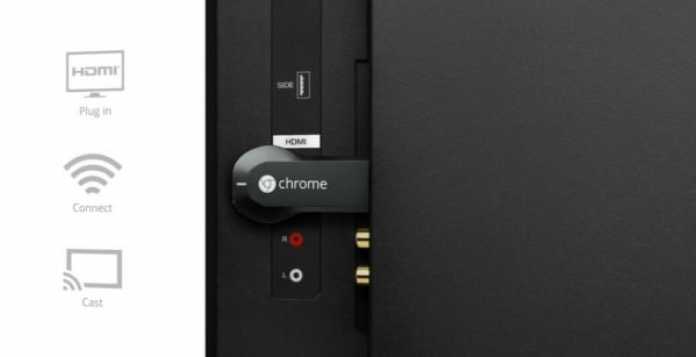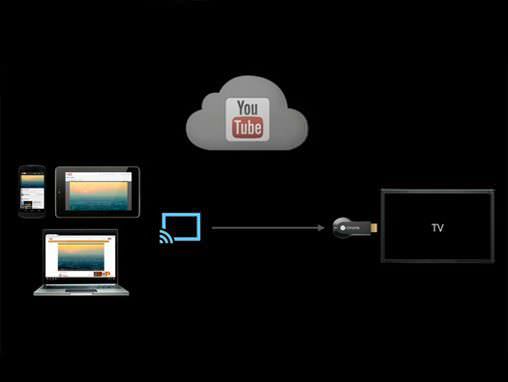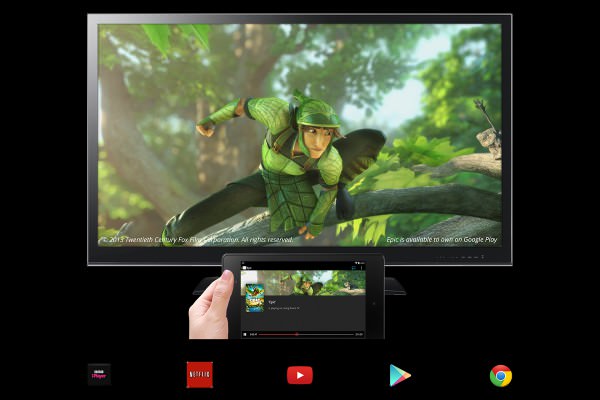Living rooms are no longer limited to mere television sets playing different cable channels. They now house a number of inter-related devices connected via a great jumble of intricate wiring. For neat freaks who are very organized, taking care of these wires is no biggie; just roll them up and stow them. But for most of us, these wires are never organized and every now and then we find ourselves in a sticky situation; they tie-up on their own, mix-up with each other or simply get lost. Luckily for the likes of us, with the latest technological advancements being made every day, Google has launched ‘Chromecast’ to resolve all wire related issues. This new Google Chromecast has revolutionized the way we connect to our devices.
It is time thus to thankfully say goodbye to wiring techniques and lengthy HDMI cables, and say hello to Google Chromecast!
Introducing Google’s New Chromecast!
Basically, the Chromecast is a media player which utilizes your TV screen to work. It plugs into the HDMI port of your television and requires a mini-USB to power up and operate (so you need a TV which has both HDMI and USB ports to run Chromecast, (Check the best OS Smart Tvs for 2014). The Chromecast does not have an OS of its own, so you don’t get to operate it like you would a Smart TV. The only function the Chromecast has been designed to perform is the ability to ‘cast’ whatever you want from your laptop/smartphone/tablet onto the big screen TV using Wi-Fi. It requires no installation, no service, and no passwords. You only need to connect it once to your Wi-Fi and its fully operational.
What is the ‘cast’ technology?
The technology behind Google Chromecast is very simple: it is Wi-Fi. Chromecast uses AzureWave NH-387 Wi-Fi, which is the most up-to-date Wi-Fi technology. With support for 802.11b/g/n (2.4 GHz), Chromecast can handle all sizes of media seamlessly. Apart from connectivity (which is the most important aspect of Google Chromecast), the ‘cast’ would not be complete without a 512mb of RAM and 2GB of storage. The RAM accompanies a small processor which has been installed inside of Chromecast to allow it to process codecs for various file formats that you may require it to play. Google Chromecast is able to play all common file formats, including H.264.
Is Google the pioneer in the ‘cast’ technology?
It is safe to say that Miracast was in the industry with a peer-to-peer technology way before Google even thought about incorporating it into Chromecast. Miracast was launched in September 2012, whereas the Google Chromecast was not launched until July 2013. The Android platform, owned by Google, initially did support Miracast until the 4.2 update.
After Android 4.2, however, the official reports by Google do not support Miracast but come with support for Google’s own Chromecast. However is this disownment due to Google’s Chromecast release or on part of Miracast not being up to the mark? The latter seems to be the case, as Miracast cannot run on all Wi-Fi networks, and needs to be certified to do so. Chromecast emerges as a clear industry winner, hence Google has shifted its loyalties to its own clearly superior product.
Do you need the Google Chromecast?
If you are tech savvy or live and breathe while interacting with technology, then you need a Chromecast dongle to make your life easier. Below mentioned are some of the key uses a Chromecast device can offer to you.
A television is perhaps the largest screen you currently own, and on average people own a TV set of around 32” minimum. Comparatively, laptops, tablets, and smartphones max out on screen sizes at 17”, 10”, and 5.5”, respectively. So Chromecast gives you the advantage of sharing, what you view on your smaller gadgets, onto your large TV set without any hassle. To be able to view media on your television is especially great when you want to watch movies that can be streamed on the tablet/laptop using your Amazon, Netflix, iTunes account. This basically eradicates the need for a Smart TV, which is costlier and more difficult to operate.
Another major use of Chromecast is mobility. Suppose you have a presentation that needs to be presented to large audiences at multiple locations or a smaller presentation for people’s homes to create awareness about a disease. The most hassle free way to do so is to connect your Chromecast device to their TV set, and then just use your tablet to stream the presentation on their TV through Chromecast. It’s that simple!
Lastly, the comfort Chromecast provides is remarkable. It has taken the wireless movement to a whole new level. Basically, with the availability of Chromecast in the market, the need for lengthy HDMI cables, Ethernet wires, and HDMI-out ports has been fully eliminated. Now, even if your device does not have an HDMI-out port (a feature which is highly sought-after in this age), you need not worry; you just need Chromecast and Wi-Fi to stream HD content on your television. Also, the ability to stream whatever you want on your TV set without moving a muscle is awesome; you just have to click on the designated icons on your tablet/smartphone/laptop and your content starts streaming onto your TV through Chromecast almost instantly.
Is Chromecast worth the price?
For its current price of $35, (Its less on Amazon!! Check it out HERE ) Chromecast is definitely worth every penny you pay for it. Although with the prospect of Smart TV this device seems redundant, but don’t forget that Smart TVs are still very expensive and not within the reach of everyone.
(Have a look at the best smart tvs for 2014 and what you need to know)
With Chromecast, you have the opportunity to turn your TV into a Smart TV at a much lesser cost. So with all its features and the functions, getting a Smart TV while this little dongle is around seems highly pointless. Besides, it’s Google’s product. The brand image of Google is enough to provide reasonable assurance to all of us about Chromecast’s excellence.























